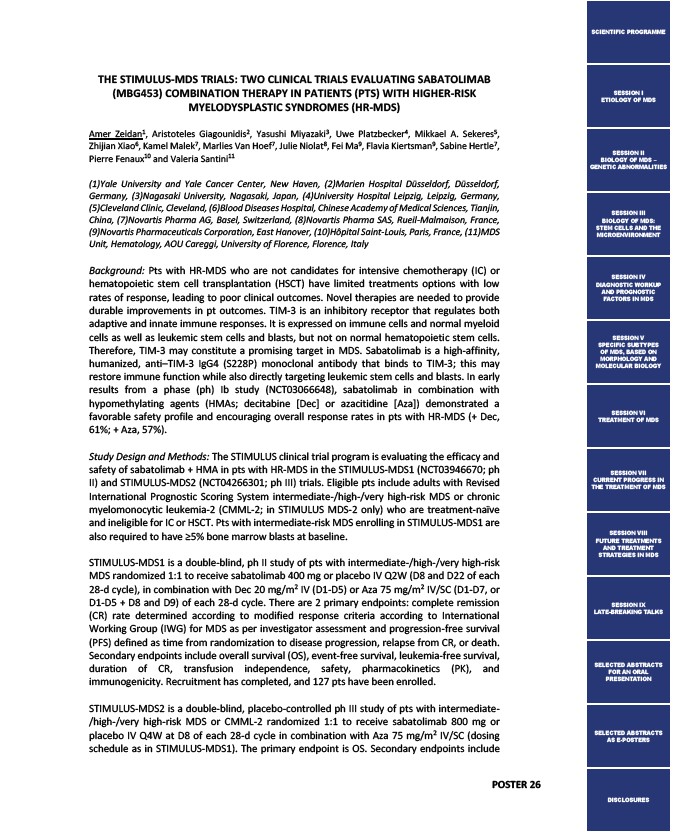
THE STIMULUS-MDS TRIALS: TWO CLINICAL TRIALS EVALUATING SABATOLIMAB
(MBG453) COMBINATION THERAPY IN PATIENTS (PTS) WITH HIGHER-RISK
MYELODYSPLASTIC SYNDROMES (HR-MDS)
Amer Zeidan1, Aristoteles Giagounidis2, Yasushi Miyazaki3, Uwe Platzbecker4, Mikkael A. Sekeres5,
Zhijian Xiao6, Kamel Malek7, Marlies Van Hoef7, Julie Niolat8, Fei Ma9, Flavia Kiertsman9, Sabine Hertle7,
Pierre Fenaux10 and Valeria Santini11
(1)Yale University and Yale Cancer Center, New Haven, (2)Marien Hospital Düsseldorf, Düsseldorf,
Germany, (3)Nagasaki University, Nagasaki, Japan, (4)University Hospital Leipzig, Leipzig, Germany,
(5)Cleveland Clinic, Cleveland, (6)Blood Diseases Hospital, Chinese Academy of Medical Sciences, Tianjin,
China, (7)Novartis Pharma AG, Basel, Switzerland, (8)Novartis Pharma SAS, Rueil-Malmaison, France,
(9)Novartis Pharmaceuticals Corporation, East Hanover, (10)Hôpital Saint-Louis, Paris, France, (11)MDS
Unit, Hematology, AOU Careggi, University of Florence, Florence, Italy
Background: Pts with HR-MDS who are not candidates for intensive chemotherapy (IC) or
hematopoietic stem cell transplantation (HSCT) have limited treatments options with low
rates of response, leading to poor clinical outcomes. Novel therapies are needed to provide
durable improvements in pt outcomes. TIM-3 is an inhibitory receptor that regulates both
adaptive and innate immune responses. It is expressed on immune cells and normal myeloid
cells as well as leukemic stem cells and blasts, but not on normal hematopoietic stem cells.
Therefore, TIM-3 may constitute a promising target in MDS. Sabatolimab is a high-affinity,
humanized, anti–TIM-3 IgG4 (S228P) monoclonal antibody that binds to TIM-3; this may
restore immune function while also directly targeting leukemic stem cells and blasts. In early
results from a phase (ph) Ib study (NCT03066648), sabatolimab in combination with
hypomethylating agents (HMAs; decitabine Dec or azacitidine Aza) demonstrated a
favorable safety profile and encouraging overall response rates in pts with HR-MDS (+ Dec,
61%; + Aza, 57%).
Study Design and Methods: The STIMULUS clinical trial program is evaluating the efficacy and
safety of sabatolimab + HMA in pts with HR-MDS in the STIMULUS-MDS1 (NCT03946670; ph
II) and STIMULUS-MDS2 (NCT04266301; ph III) trials. Eligible pts include adults with Revised
International Prognostic Scoring System intermediate-/high-/very high-risk MDS or chronic
myelomonocytic leukemia-2 (CMML-2; in STIMULUS MDS-2 only) who are treatment-naïve
and ineligible for IC or HSCT. Pts with intermediate-risk MDS enrolling in STIMULUS-MDS1 are
also required to have ≥5% bone marrow blasts at baseline.
STIMULUS-MDS1 is a double-blind, ph II study of pts with intermediate-/high-/very high-risk
MDS randomized 1:1 to receive sabatolimab 400 mg or placebo IV Q2W (D8 and D22 of each
28-d cycle), in combination with Dec 20 mg/m2 IV (D1-D5) or Aza 75 mg/m2 IV/SC (D1-D7, or
D1-D5 + D8 and D9) of each 28-d cycle. There are 2 primary endpoints: complete remission
(CR) rate determined according to modified response criteria according to International
Working Group (IWG) for MDS as per investigator assessment and progression-free survival
(PFS) defined as time from randomization to disease progression, relapse from CR, or death.
Secondary endpoints include overall survival (OS), event-free survival, leukemia-free survival,
duration of CR, transfusion independence, safety, pharmacokinetics (PK), and
immunogenicity. Recruitment has completed, and 127 pts have been enrolled.
STIMULUS-MDS2 is a double-blind, placebo-controlled ph III study of pts with intermediate-
/high-/very high-risk MDS or CMML-2 randomized 1:1 to receive sabatolimab 800 mg or
placebo IV Q4W at D8 of each 28-d cycle in combination with Aza 75 mg/m2 IV/SC (dosing
schedule as in STIMULUS-MDS1). The primary endpoint is OS. Secondary endpoints include
POSTER 26
SCIENTIFIC PROGRAMME
SESSION I
ETIOLOGY OF MDS
SESSION II
BIOLOGY OF MDS –
GENETIC ABNORMALITIES
SESSION III
BIOLOGY OF MDS:
STEM CELLS AND THE
MICROENVIRONMENT
SESSION IV
DIAGNOSTIC WORKUP
AND PROGNOSTIC
FACTORS IN MDS
SESSION V
SPECIFIC SUBTYPES
OF MDS, BASED ON
MORPHOLOGY AND
MOLECULAR BIOLOGY
SESSION VI
TREATMENT OF MDS
SESSION VII
CURRENT PROGRESS IN
THE TREATMENT OF MDS
SESSION VIII
FUTURE TREATMENTS
AND TREATMENT
STRATEGIES IN MDS
SESSION IX
LATE-BREAKING TALKS
SELECTED ABSTRACTS
FOR AN ORAL
PRESENTATION
SELECTED ABSTRACTS
AS E-POSTERS
DISCLOSURES